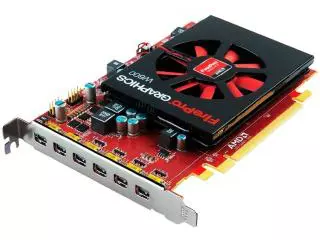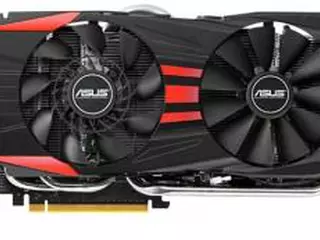FirePro W600 vs Radeon R9 280
When choosing between FirePro W600 and Radeon R9 280, it is worth examining the specifications of the models in detail. Do they meet the recommended requirements of modern games and software? Storage capacity, form factor, TDP, available ports, warranty and manufacturer support are all important. For example, the size of a PC case can limit the maximum thickness and length of the card. Often, instead of the factory overclocked card and RGB backlight, it is better to choose a reference model with a more efficient GPU. And make sure that your current power supply unit has the correct connection pins (using adapters is not recommended). This GPUs compare tool is meant to help you to choose the best graphics card for your build. Let's find out the difference between FirePro W600 and Radeon R9 280.
Main Specs
FirePro W600
Radeon R9 280
Power consumption (TDP)
75 Watt
200 Watt
Interface
PCIe 3.0 x16
PCIe 3.0 x16
Supplementary power connectors
None
1 x 6-pin + 1 x 8-pin
Memory type
GDDR5
GDDR5
Maximum RAM amount
2 GB
3 GB
Display Connectors
6x mini-DisplayPort
2x DVI, 1x HDMI, 2x mini-DisplayPort
Check Price
Check Price
Radeon R9 280 has 166% more power consumption, than FirePro W600.
Both video cards are using PCIe 3.0 x16 interface connection to a motherboard.
Radeon R9 280 has 1 GB more memory, than FirePro W600.
Both cards are used in Desktops.
FirePro W600 and Radeon R9 280 are build with GCN 1.0 architecture.
FirePro W600 and Radeon R9 280 are manufactured by 28 nm process technology.
Radeon R9 280 is 112 mm longer, than FirePro W600.
Memory clock speed of FirePro W600 is 2750 MHz higher, than Radeon R9 280.
Game benchmarks
Assassin's Creed Odyssey
Battlefield 5
Call of Duty: Warzone
Counter-Strike: Global Offensive
Cyberpunk 2077
Dota 2
Far Cry 5
Fortnite
Forza Horizon 4
Grand Theft Auto V
Metro Exodus
Minecraft
PLAYERUNKNOWN'S BATTLEGROUNDS
Red Dead Redemption 2
The Witcher 3: Wild Hunt
World of Tanks
high / 1080p
8−9
35−40
ultra / 1080p
5−6
21−24
QHD / 1440p
0−1
16−18
4K / 2160p
−
10−11
low / 720p
18−20
60−65
medium / 1080p
10−11
40−45
The average gaming FPS of Radeon R9 280 in Assassin's Creed Odyssey is 310% more, than FirePro W600.
high / 1080p
14−16
55−60
ultra / 1080p
12−14
45−50
QHD / 1440p
0−1
35−40
4K / 2160p
−
18−20
low / 720p
27−30
100−110
medium / 1080p
14−16
60−65
The average gaming FPS of Radeon R9 280 in Battlefield 5 is 300% more, than FirePro W600.
low / 768p
45−50
50−55
high / 1080p
45−50
−
QHD / 1440p
0−1
0−1
The average gaming FPS of Radeon R9 280 in Call of Duty: Warzone is 10% more, than FirePro W600.
low / 768p
150−160
250−260
medium / 768p
120−130
220−230
ultra / 1080p
60−65
180−190
QHD / 1440p
30−35
110−120
4K / 2160p
27−30
70−75
high / 768p
90−95
210−220
The average gaming FPS of Radeon R9 280 in Counter-Strike: Global Offensive is 115% more, than FirePro W600.
low / 768p
55−60
60−65
ultra / 1080p
21−24
−
medium / 1080p
45−50
55−60
The average gaming FPS of Radeon R9 280 in Cyberpunk 2077 is 15% more, than FirePro W600.
low / 768p
85−90
120−130
medium / 768p
65−70
110−120
ultra / 1080p
35−40
100−110
The average gaming FPS of Radeon R9 280 in Dota 2 is 79% more, than FirePro W600.
high / 1080p
10−11
45−50
ultra / 1080p
9−10
40−45
QHD / 1440p
−
27−30
4K / 2160p
4−5
14−16
low / 720p
21−24
80−85
medium / 1080p
10−11
45−50
The average gaming FPS of Radeon R9 280 in Far Cry 5 is 327% more, than FirePro W600.
high / 1080p
16−18
60−65
ultra / 1080p
12−14
45−50
QHD / 1440p
−
27−30
4K / 2160p
−
27−30
low / 720p
65−70
180−190
medium / 1080p
27−30
110−120
The average gaming FPS of Radeon R9 280 in Fortnite is 229% more, than FirePro W600.
high / 1080p
14−16
60−65
ultra / 1080p
12−14
45−50
QHD / 1440p
2−3
30−35
4K / 2160p
−
24−27
low / 720p
30−35
100−110
medium / 1080p
16−18
65−70
The average gaming FPS of Radeon R9 280 in Forza Horizon 4 is 293% more, than FirePro W600.
low / 768p
55−60
140−150
medium / 768p
50−55
120−130
high / 1080p
14−16
70−75
ultra / 1080p
7−8
30−35
QHD / 1440p
0−1
21−24
The average gaming FPS of Radeon R9 280 in Grand Theft Auto V is 181% more, than FirePro W600.
high / 1080p
5−6
24−27
ultra / 1080p
4−5
20−22
QHD / 1440p
−
16−18
4K / 2160p
1−2
8−9
low / 720p
14−16
65−70
medium / 1080p
7−8
30−35
The average gaming FPS of Radeon R9 280 in Metro Exodus is 416% more, than FirePro W600.
low / 768p
95−100
130−140
high / 1080p
90−95
−
ultra / 1080p
85−90
−
medium / 1080p
95−100
120−130
The average gaming FPS of Radeon R9 280 in Minecraft is 34% more, than FirePro W600.
high / 1080p
18−20
−
ultra / 1080p
14−16
14−16
low / 720p
35−40
100−110
medium / 1080p
18−20
18−20
The average gaming FPS of Radeon R9 280 in PLAYERUNKNOWN'S BATTLEGROUNDS is 100% more, than FirePro W600.
high / 1080p
−
24−27
ultra / 1080p
8−9
16−18
QHD / 1440p
0−1
10−11
4K / 2160p
−
7−8
low / 720p
14−16
65−70
medium / 1080p
12−14
35−40
The average gaming FPS of Radeon R9 280 in Red Dead Redemption 2 is 233% more, than FirePro W600.
low / 768p
30−33
130−140
medium / 768p
18−20
85−90
high / 1080p
10−12
45−50
ultra / 1080p
7−8
24−27
4K / 2160p
6−7
16−18
The average gaming FPS of Radeon R9 280 in The Witcher 3: Wild Hunt is 313% more, than FirePro W600.
low / 768p
85−90
90−95
medium / 768p
45−50
60−65
ultra / 1080p
21−24
50−55
high / 768p
40−45
60−65
The average gaming FPS of Radeon R9 280 in World of Tanks is 34% more, than FirePro W600.
Full Specs
FirePro W600
Radeon R9 280
Architecture
GCN 1.0
GCN 1.0
Code name
Cape Verde
Tahiti
Type
Workstation
Desktop
Release date
13 June 2012
4 March 2014
Pipelines
512
1792
Core clock speed
750 MHz
Boost Clock
933 MHz
Transistor count
1,500 million
4,313 million
Manufacturing process technology
28 nm
28 nm
Texture fill rate
24.00
104.5
Floating-point performance
768.0 gflops
3,344 gflops
Length
163 mm
275 mm
Memory bus width
128 Bit
384 Bit
Memory clock speed
4000 MHz
1250 MHz
Memory bandwidth
64 GB/s
240 GB/s
DirectX
12 (11_1)
Shader Model
5.1
5.1
OpenGL
4.6
4.6
OpenCL
1.2
1.2
Vulkan
1.2.131
+
FreeSync
+
Bus support
PCIe 3.0
HDMI
+
Bitcoin / BTC (SHA256)
94 Mh/s
408 Mh/s
Eyefinity
+
HD3D
+
TrueAudio
+
Design
reference
CrossFire
+
DDMA audio
+
Ethereum / ETH (DaggerHashimoto)
21.5 Mh/s
LiquidVR
+
TressFX
+
UVD
+
Check Price
Check Price

